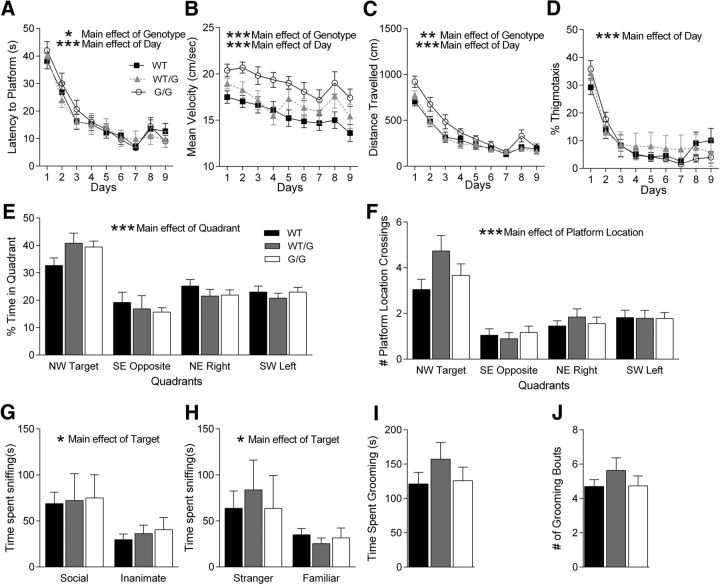Figure 4.
Shank3G/G mice exhibit mild spatial learning impairment, normal social interaction, and normal grooming behavior. A–D, Training days for the Morris water maze task. For each day of training, data were averaged across four daily trials. A, Latency to reach hidden platform on successive water maze days. Shank3G/G mice take longer to reach the submerged platform. Legend in A applies to B–D. B, Swim speed on successive water maze training days. Shank3G/G mice swim faster in the water maze. C, Distance traveled before reaching the hidden platform on successive water maze training days. Shank3G/G mice travel a longer distance before reaching the submerged platform. D, Percentage time spent in thigmotaxis on successive water maze training days. Shank3G/G mice spend the same amount of time in the thigmotaxis region as their littermate controls. E, Time spent in target quadrant and other quadrants during probe trial in which target platform is removed. Shank3G/G mice spend more time in the target quadrant versus other quadrants. Legend in E applies to F–J. F, Number of target location crossings and corresponding phantom platform location crossings in other quadrants during the probe trial. Shank3G/G mice show a clear preference for the target platform location: WT, n = 22; Shank3WT/G, n = 19; Shank3G/G, n = 18. G, In the three chambered social interaction test, all groups show a normal preference for the social versus the inanimate target and (H) for the stranger mouse versus the familiar mouse: WT, n = 19; Shank3WT/G, n = 15; Shank3G/G, n = 15. I, Shank3G/G mice show no change in total time spent grooming or (J) number of grooming bouts in a 10 min period: WT, n = 23; Shank3WT/G, n = 19; Shank3G/G, n = 19. *p < 0.05. **p < 0.01. ***p < 0.001.

